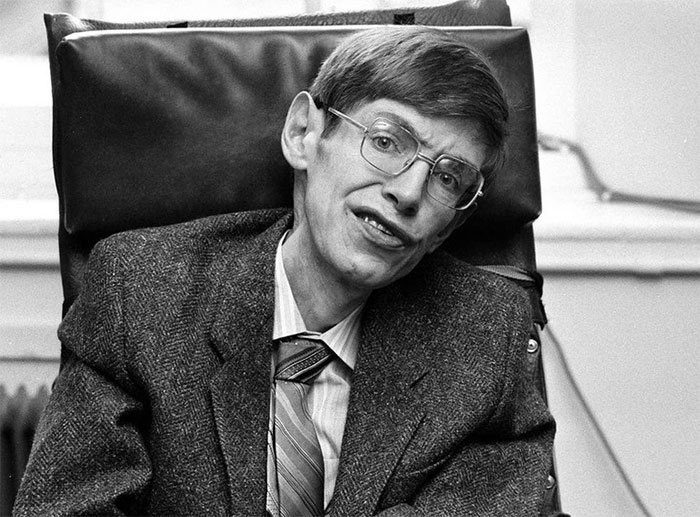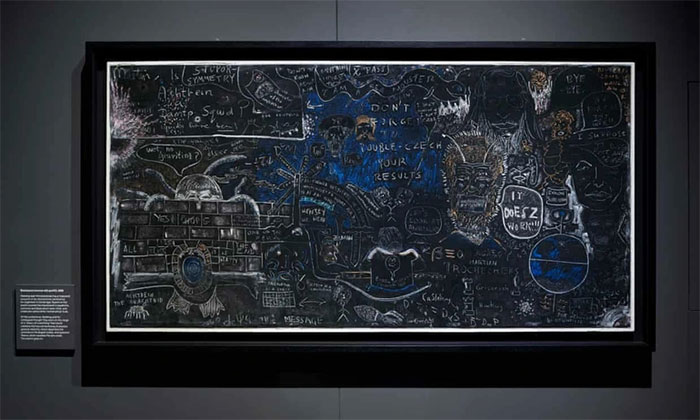The Mystery of Stephen Hawking's Scribbled Blackboard
What is "Exxon gravitation", who is the bearded "Mars", what does the squid hanging on the wall mean? All will be answered soon.
Dedicating his life to finding answers to the universe's most difficult questions, "physics legend" Stephen Hawking has left a mystery of his own right in his old office, which is a blackboard with a blackboard. full of drawings, scribbled captions.

"Physics legend" Stephen Hawking devoted his life to world science, leaving behind a lot of valuable knowledge.
On display at the Science Museum in London, the blackboard is both an intricate work of art, but at the same time a memento of the history of physics, which may need more time. to be able to elucidate.
The blackboard, which dates back to 1980, was used by Hawking to take notes with other physicists when they attended a conference on superspace and supergravity at the University of Cambridge in the UK.
In trying to come up with a "new theory of everything" that exists in the universe - or a set of equations that combine the rules of general relativity and quantum mechanics, Hawking's colleagues Fill the board with a series of completed equations, combined with cryptic puns and doodles, even mysterious drawings.
Many strange theories were first mentioned, such as "stupor symmetry", or prominently the image of a bearded Martian drawn in the center of the board to make viewers feel. hard to understand. In addition, there is also an image of a squid climbing over a brick wall, or a box labeled "Exxon Super Gravity".

Could Stephen Hawking's scribbled blackboard contain a message that changed humanity?
"I'll definitely try to extract their interpretations, but I'm not sure I have enough knowledge," said Juan-Andres Leon, Stephen Hawking's office manager, who was also one of the witnesses who attended. conference more than 40 years ago, said.
"People don't get a lot of glimpses of Stephen Hawking's day-to-day life, and because he's a theoretical physicist, it's difficult to convey what's on his mind," says Leon. receive.
Previously, it was suggested that Hawking and his colleagues only used the blackboard as a distraction, to cover up important knowledge with a series of pseudo equations or unrelated notes. like. There are also people who think that they just see this as a hobby, and the information really has no meaning.
Leon hopes that when the board is made public, the world's great minds in the fields of mathematics and physics will be able to answer what Hawking implicitly tells humanity based on Mysterious notes are recorded.
The blackboard is just one of more than 700 objects classified by staff at the Science Museum after they were taken from Hawking's office. classified since they arrived last summer. In time, all of these objects will be photographed and described to all museum visitors.

Stephen Hawking was awarded the Presidential Medal of Freedom by US President Barack Obama in 2009.
Physicist Stephen Hawking (January 8, 1942 - March 14, 2018), died at the age of 76. He was also a cosmologist, astronomer, mathematician and author of many books. including "A Brief History of Time", which has sold over 10 million copies. He was diagnosed with ALS (amyotrophic lateral sclerosis), a neurodegenerative disease also known as Lou Gehrig's Disease, which often causes death within a few years.
It was 1963, when Stephen was only 21 years old and was expected to have only a few more years to live. But with extraordinary energy, the "king of physics" not only lived, but also devoted his life to world science, leaving behind a lot of valuable knowledge.
Stephen Hawking was one of the first to show how quantum fluctuations, tiny variations in the distribution of matter, can affect the spread of galaxies in the universe. His name became known to the world in 1970, when he and physicist Roger Penrose published the work.
- The biggest mystery of scientist Stephen Hawking
- Stephen Hawking's theory about to crack the biggest mystery of science?
- The sick life of Stephen Hawking's genius has become a medical mystery
- Startled to predict the death of scientist Stephen Hawking
- What makes Stephen Hawking from lazy students a great brain of humanity?
- 20 inspirational quotes from space scientist Stephen Hawking
- Cambridge saw Stephen Hawking on his last trip
- 5 types of sounds make people afraid
- The final message of Hawking's physical genius sent to mankind
- Professor Stephen Hawking died at the age of 76
- The reason the physical prince Stephen Hawking did not win the Nobel prize
- The race for the brain of physics genius Stephen Hawking
 The most famous scientific failures in history
The most famous scientific failures in history Mysterious genius mechanic and the machine froze time
Mysterious genius mechanic and the machine froze time The son carries the 'bad gene' of genius Albert Einstein
The son carries the 'bad gene' of genius Albert Einstein Isaac Newton
Isaac Newton Why do most people with ALS not live more than 5 years, but Hawking lived to be 55?
Why do most people with ALS not live more than 5 years, but Hawking lived to be 55?  The Universe Came From Nothing: The Never-ending Story Between Science and Theology!
The Universe Came From Nothing: The Never-ending Story Between Science and Theology!  AI analyzes Stephen Hawking's concerns about another civilization
AI analyzes Stephen Hawking's concerns about another civilization  10 outstanding scientific events in the world in 2018
10 outstanding scientific events in the world in 2018  Auction for the final hand signature of the physical prince Stephen Hawking
Auction for the final hand signature of the physical prince Stephen Hawking  Professor Stephen Hawking will be buried next to Darwin and Newton
Professor Stephen Hawking will be buried next to Darwin and Newton 